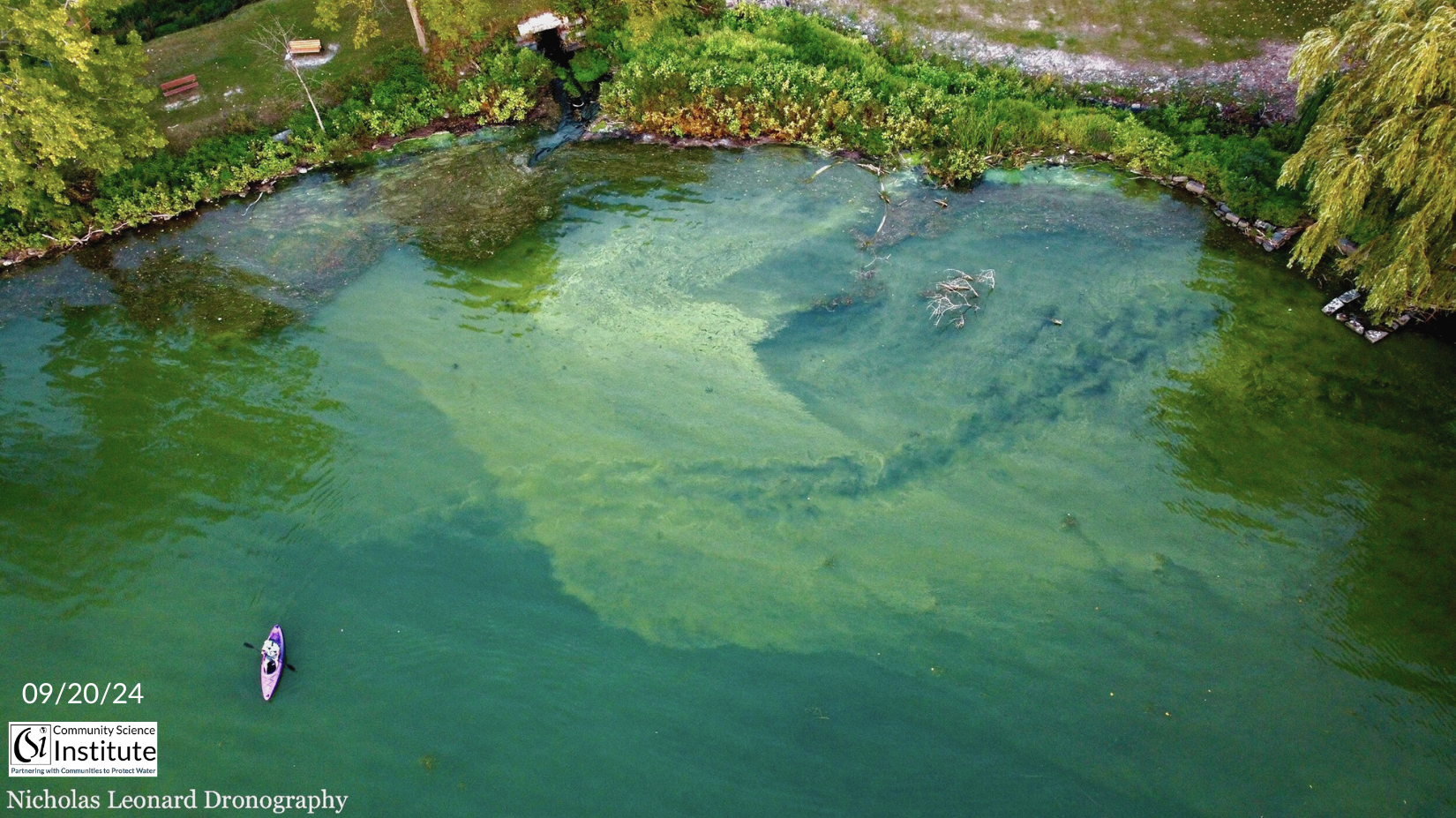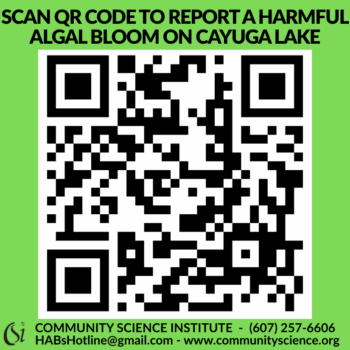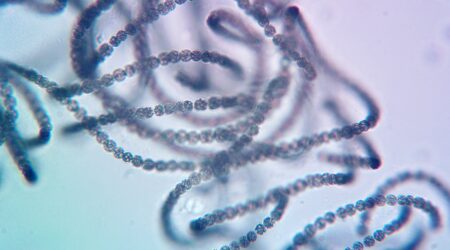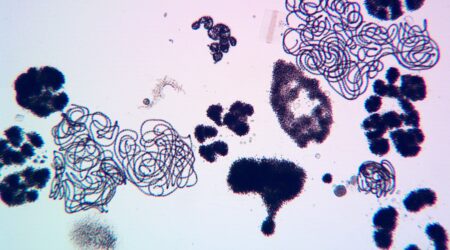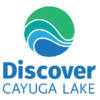The Cayuga Lake HABs Monitoring Program began in 2018 and is a large collaborative effort that brings together local and state government agencies, non-profit organizations, and community members with the shared mission of collecting actionable data on cyanobacterial blooms, protecting public health, and relaying timely bloom information and test results as quickly and efficiently as possible.
Harmful Algal Bloom Monitoring on Cayuga Lake
Cayuga Lake Harmful Algal Bloom Monitoring Program
Photo: A kayaker paddles through a harmful algal bloom (HAB) near the shoreline at Frontenac Park in Union Springs, 09/20/2024.
Captured by Nicholas Leonard Dronography.
Have you observed a suspected Harmful Algal Bloom on Cayuga Lake?
HABs can dissipate quickly. In order for one of our trained staff or volunteers to follow up with you and do a site visit, we need to be able to communicate with you within the hour of receiving your report. Please include all of the above requested information and plan to respond accordingly. Thank you for your help in monitoring Cayuga Lake!
If you are a community member and you’d like to report a suspected harmful algal bloom on Cayuga Lake, please use this Google Form:
2025 Community Member Cayuga Lake HABs Report Form
You can also send us an email to HABsHotline@gmail.com with the following required information:
-
- Your name, cell phone number, and address of where the bloom was observed.
- Any local landmarks that will help us in locating the bloom (docks, coves, etc.)
- Latitude/longitude of the bloom
- Two pictures: one taken up close of the bloom to show the texture/consistency, one wide view to show how large it is.
What are Harmful Algal Blooms?
Despite the name “Harmful Algal Blooms” or “Blue-Green Algae”, these cyanobacteria blooms are not really algae. They are bacteria, a more ancient type of organism. Among the first life forms on earth, cyanobacteria emerged some 3.5 billion years ago, at a time when the earth’s atmosphere contained virtually no oxygen. As the first photosynthetic organisms and the ancestors of modern plants, cyanobacteria produced oxygen as a waste product that accumulated in the atmosphere. Over the course of some 2.5 billion years, cyanobacteria made it possible for life forms that depend on oxygen, including eventually humans, to evolve. Cyanobacteria are a diverse group of organisms with a range of morphologies and adaptations. Some genera can fix nitrogen, others have gas vacuoles that enable them to move up and down in the water column to seek out favorable conditions. Many species of cyanobacteria produce chemical compounds whose purposes are not fully understood. A few of these natural compounds, cyanotoxins, are toxic to humans and other animals. Their presence is what makes a cyanobacteria bloom harmful.
Under the right conditions, freshwater cyanobacteria experience explosive growth, dividing rapidly and increasing their population until they become a visible bloom. Three common groups of bloom-forming cyanobacteria in Cayuga Lake are Microcystis, Dolichospermum, and Aphanizomenon. While these groups have distinctive features that can be recognized under a microscope, the blooms they form are indistinguishable to the naked eye. Additionally, there is no visual indicator of toxins that may be present in a bloom. Cyanobacteria blooms may look like parallel streaks or green clumps on the water, or they may have a spilled paint or pea soup appearance (see below).
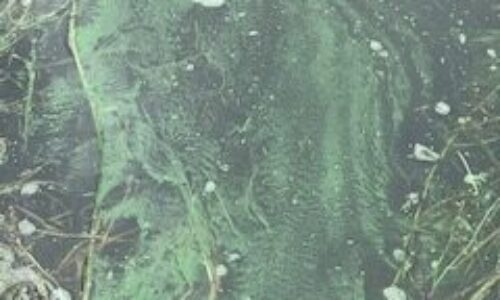


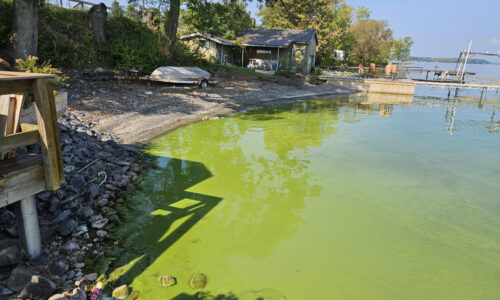
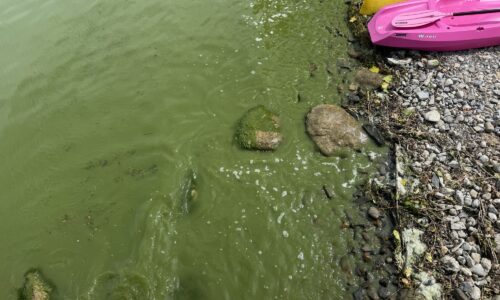
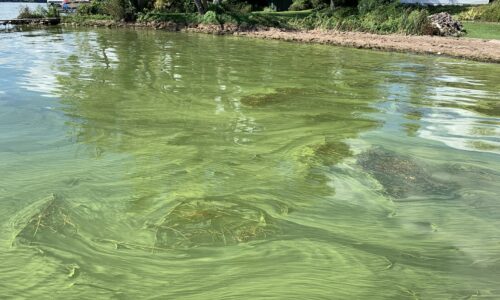
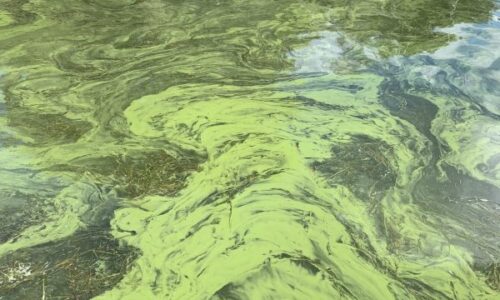
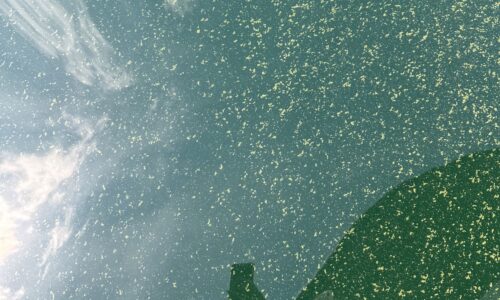
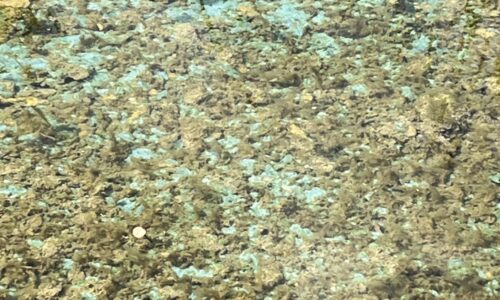
The Community Behind the HABs Monitoring Program – The HABs Harriers & Carriers
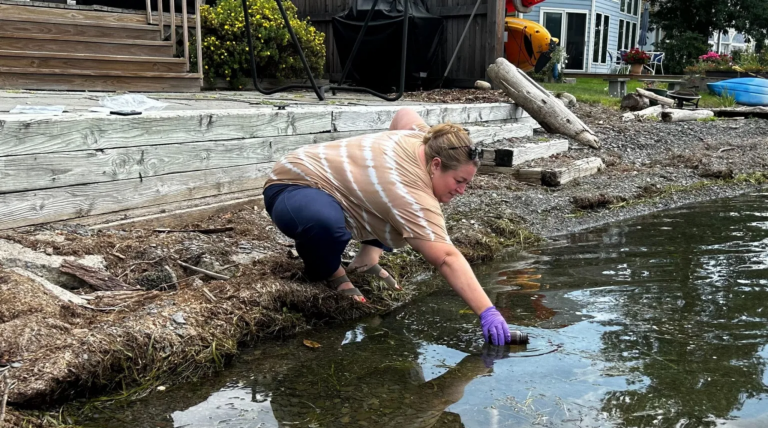
Alyssa Johnson (Cayuga Lake HABs Monitoring Program Coordinator) collects a sample of an algal bloom from Cayuga Lake on 08/28/24. Credit: Fernando Figueroa / The Ithaca Voice
The Cayuga Lake HABs Monitoring Program would not be possible without the support and engagement of the Cayuga Lake community stretching from Ithaca to Seneca Falls, and on both the eastern and western shores. In 2024, we had our largest volunteer group participating in the HABs monitoring program since we began in 2018 with over 100 volunteers participating!
For more information about the 2024 season, please read two articles in the 2024 Water Bulletin “Record-Breaking HABs Season Sparks Community Action and Science on Cayuga Lake” and “Results from the 2024 HAB Clump Pilot Study: Are Cyanobacteria Clumps in Cayuga Lake Something We Should Be Concerned About?”. Additionally, end of year program stats are included in our 2024 Annual Report.
- All new and returning volunteers are required to attend an annual orientation led by CSI’s Cayuga Lake Harmful Algal Bloom Monitoring Program Coordinator.
- HABs Harriers (volunteers who are monitoring the shoreline for HABs) are assigned a “zone” of shoreline that they are responsible for monitoring at least weekly during the official monitoring season set by the NYS Department of Environmental Conservation. Once zones are assigned, a unique four digit code starting with 34– is designated to each zone. These zone codes are used for bloom tracking and reporting purposes.
- HABs Harriers are responsible for submitting a “No Bloom Report” via a Google form during the weeks a HAB was not detected in their zone. If a HAB is suspected in their zone, then the protocol dictates that the Harrier fill out “Bloom Report” via a Google form immediately.
- In 2025 the sample collection protocol has changed. Only some volunteers will be asked to collect samples at a subset of priority sampling locations. These locations were identified as priority areas by Tompkins County Whole Health, Cayuga County Health Department and Seneca County Health Department – the three primary funders of the Cayuga Lake HABs Monitoring Program. These priority areas include public water supplies, unregulated swimming beaches, or boat launches.
- This is where our HABs Carriers step in to assist! This volunteer role (new in 2023) aid in the transportation of samples from around Cayuga Lake. Samples must arrive to the lab within 48 hours of collection to preserve the sample’s integrity. Carriers are instrumental in ensuring that samples arrive from the northern end of the lake on time.
Resources for Community Members, Residents, and Visitors
- 2025 Community Member Cayuga Lake HABs Report Form
- CSI Cayuga Lake HABs Database
- Subscribe to Cayuga Lake Watershed Network’s Weekly HABs Updates
- NYHABs Map
- NYSPark Beach Results Map
- Dogs & Harmful Algal Blooms -New York Sea Grant
- NYSDEC HABs Information Page
- Harmful Blue-green Algae Blooms: Understanding the Risks of Piping Surface Water into Your Home
- HABs Identification Training Video
- Harmful Algal Bloom Action Plan Cayuga Lake
We need your help!
In an effort to increase community participation and Cayuga Lakes shoreline monitoring coverage as the program continues to grow, we recruit new volunteers on an annual basis.
Interested in becoming a new volunteer?
Please fill this brief form out to get started!
Analyzing Harmful Algal Bloom Samples for Cyanobacteria
CSI Analyses: The CSI lab is equipped to perform three analyses on suspicious blooms: microscopy, total chlorophyll a, and microcystin. If initial inspection under the microscope confirms the presence of cyanobacteria, then chlorophyll a and microcystin analyses are performed.
- Microscopy
- All samples received by the CSI lab are first assessed by microscopy, carefully looking at samples under the microscope, to characterize general bloom composition and determine if cyanobacteria are present in the bloom.
- Total Chlorophyll a
- If cyanobacteria are present, total chlorophyll a is used to estimate the biomass of the cyanobacteria bloom. Total Chlorophyll a is determined using spectrophotometry and results are reported in units of parts per billion (ppb) or micrograms/liter (ug/L).
- Microcystin
- Cyanobacteria produce a variety of natural chemicals, a few of which are harmful to other species, including humans. The most common harmful chemical found in New York is microcystin. Detailed toxicity studies have not been performed, and there is not yet a consensus on acceptable exposure levels. The New York State Department of Health (NYSDOH) has set safe limits for public drinking water supplies at 0.3 ug/L and for public swimming beaches at 4.0 ug/L (EPA, 2017). The New York State Department of Environmental Conservation (NYSDEC) defines a “bloom with high toxin” as 20 ug/L near the shore and 10 ug/L in open water (NYSDEC HABs Program Guide, Section 3).
Microcystin toxin is measured using EPA Method 546 which is an enzyme-linked immunosorbent assay (ELISA). CSI reports results down to the drinking water standard of 0.3 ppb (EPA, 2015). - Microcystin toxin is measured using EPA Method 546 which is an enzyme-linked immunosorbent assay (ELISA). CSI reports results down to the drinking water standard of 0.3 ppb (EPA, 2015).
- Cyanobacteria produce a variety of natural chemicals, a few of which are harmful to other species, including humans. The most common harmful chemical found in New York is microcystin. Detailed toxicity studies have not been performed, and there is not yet a consensus on acceptable exposure levels. The New York State Department of Health (NYSDOH) has set safe limits for public drinking water supplies at 0.3 ug/L and for public swimming beaches at 4.0 ug/L (EPA, 2017). The New York State Department of Environmental Conservation (NYSDEC) defines a “bloom with high toxin” as 20 ug/L near the shore and 10 ug/L in open water (NYSDEC HABs Program Guide, Section 3).
Who's Involved - Leadership and Partners
The Cayuga Lake HABs monitoring program is led by a group of three environmental non-profits backed with some programmatic assistance from the New York State Department of Environmental Conservation. This Cayuga Lake Water Quality Consortium includes the Community Science Institute, Cayuga Lake Watershed Network, and Discover Cayuga Lake.

Community Science Institute
CSI is an Ithaca based environmental non-profit that operates a certified water testing lab, works with volunteers to monitor water quality in streams and lakes, and disseminates water quality data on CSI’s online database with the mission of fostering environmental stewardship.
CSI tests cyanobacteria bloom samples at the CSI lab in Ithaca, recruits and trains volunteers, and manages program logistics including the dissemination of test results via the Cayuga Lake HABs Results Page. CSI also reports the Cayuga Lake HABs data to the DEC NYHABs statewide reporting page.
Cayuga Lake Watershed Network
The Cayuga Lake Watershed Network (CLWN) identifies key threats to Cayuga Lake and its watershed, and advocates for solutions that support a healthy environment and sustainable, vibrant communities.
CLWN maintains communications and networking between project partners and the watershed public, including public agencies, concerned residents, and municipalities.
Discover Cayuga Lake
Discover Cayuga Lake (DCL) provides experiential learning opportunities that promote academic achievement, environmental literacy, and lifelong relationships with the waterways that define our communities.
During their daily voyages, DCL keeps a close eye on Cayuga Lake, monitors changes in the lake’s phytoplankton community, and educates passengers of all ages on cyanobacteria blooms and what’s being done to address them.
![]()


